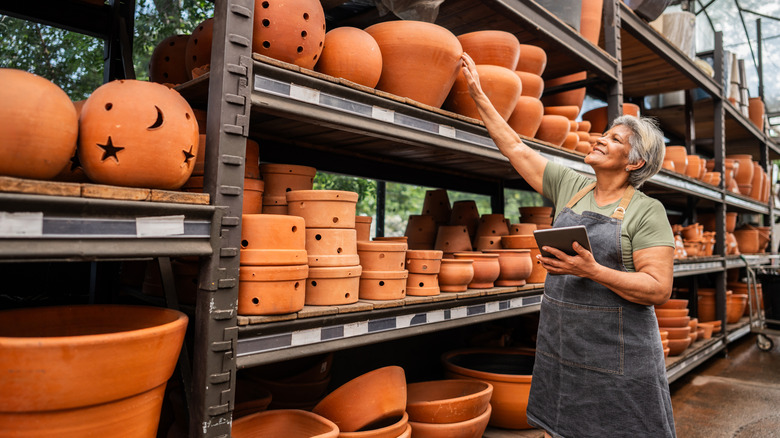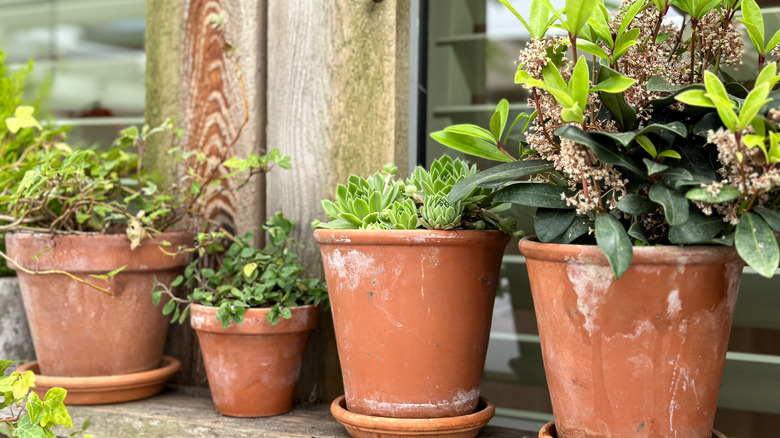Are Terracotta Pots The Best For Plants?
You have lots of choices when potting plants, and you might think the type of pot or container you use isn't an important decision — but it can actually be pretty significant. Whether potting to grow seedlings, decorative floral mixes, herbs, or veggies, you'll want to look at appearance, porosity, material, weight, color, drainage, size, price, and sustainability in determining the right pot for each plant, along with how you plan to use the pot. Choices include plastic, polystyrene foam, fabric, ceramic, metal, concrete, wood, and terracotta, just to name a few. Plastic pots dominate the market, with terracotta in second place.
Terracotta is probably what most people picture when "flower pot" is mentioned. But is it universally the best pot for plants? Let's break it down, starting with the factors most important to plant health. Porosity is a distinctive characteristic of terracotta, but it's a double-edged sword. Porosity means healthy roots because air can penetrate the pot, and its sides wick away excess water from the soil. But highly porous posts also mean the soil will dry out faster. It's important to know there are two types of terracotta — and choosing the right one matters. Terracotta pots come in glazed or unglazed versions, and the glazed pots are not porous. Glazed terracotta pots have their place, though, because they work well with moisture-loving plants. Check for a drainage hole, as some pots lack them.
As opposed to thin plastic, the clay that terracotta is made from excels at regulating soil temperature, keeping roots cozy, and protecting the plant from temperature extremes. Terracotta also beats plastic for drainage, so it's well-suited for plants needing very well-drained soil.
Terracotta pots are great for most plants
Apart from plant health, one feature of terracotta to note is that it breaks easily. Plastic, conversely, degrades and becomes brittle over time. Terracotta cracks in cold weather, though you can learn how to prevent your terracotta pots from cracking. Terracotta's heavy weight can be an issue for some, as can the lightness of plastic pots that can easily tip or blow over.
Terracotta also fares well in terms of appearance. Who doesn't love the warm, reddish-brown of a terracotta pot? Yet, plastic pots offer a greater variety of colors. A byproduct of terracotta's ability to wick water from the soil can affect appearance. Eventually, mineral salt residue appears on the terracotta pot, leaving a crusty, white mottling, which some gardeners find rustic and charming and others feel is unappealing. If you're in the latter group, use olive oil on your favorite terracotta planter to improve its appearance. Whether terracotta or plastic, pot size shouldn't be a problem (though some experts suggest plastic offers a greater selection of sizes). Terracotta is far more sustainable than plastic, but it's not biodegradable. Still, terracotta pots can be repurposed in numerous ways, such as turning broken terracotta planters into a DIY mulch that helps repel slugs. Plastic pots are the runaway winners when it comes to affordability.
Dating back at least to the Roman Empire, terracotta pots have stood the test of time. Bottom line: These clay pots will ensure a healthy home for most plants. Considerations such as price, weight, and durability might sway you toward plastic, but as long as you're not potting super-thirsty plants that won't thrive when grown in a terracotta pot, these ancient clay pots will serve your garden well.

